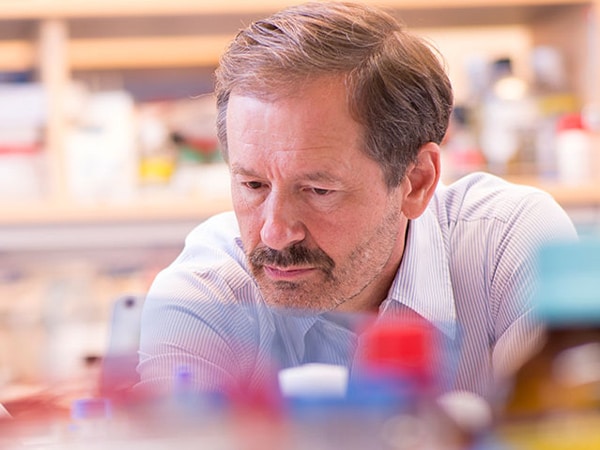How the Tumor Microenvironment Supports or Stifles Cancer Growth
Ashani Weeraratna, PhD, and Ekrem Emrah Er, PhD, explain how a tumor’s surroundings direct its growth and progression, and research presented at the AACR Annual Meeting 2022 shows how scientists can manipulate those surroundings to treat cancer.
Cancer cells are often viewed as renegades—cells that go rogue, living on their own terms, free from the rules that control nonmalignant cells. Some of the most renowned and notorious rebels, however, have relied on those around them. Bonnie and Clyde, for example, needed their Barrow Gang.
Tumors, in a similar fashion, rely on their microenvironment—the cells, proteins, and other factors that exist alongside the malignant cells and influence their behavior. A tumor could not survive without these elements, but that doesn’t mean they always help the cancer cells.
“I think of the tumor microenvironment as a neighborhood,” said Ashani Weeraratna, PhD, a Bloomberg Distinguished Professor of Cancer Biology at the Johns Hopkins Schools of Medicine and Public Health. “The tumor is one family that lives in the neighborhood, and the rest of the neighborhood influences the tumor to behave the way it does.”
Dr. Weeraratna, who is also a member of the AACR Tumor Microenvironment Working Group steering committee, described some of the elements of these tumor neighborhoods. Nonmalignant cells surrounding the tumor mass send signals to the cancer cells; some, such as cancer-associated fibroblasts, build a favorable niche for the cancer to thrive. Blood vessels also boost the tumor’s development, bringing in nutrients and helping to disseminate metastatic cells.
Immune cells with various functions infiltrate many tumors. Cytotoxic T cells can directly attack cancer cells, and B cells produce antibodies that boost immune responses. Tumor-associated macrophages can either work with other immune cells to promote cancer cell death, or they can support the tumor by promoting metastasis and blocking immune responses.
Beyond cells, the tumor microenvironment also contains proteins and other molecules that influence tumor behavior. A scaffold called the extracellular matrix physically envelops the tumor, providing structural support and mechanical feedback. Signaling molecules such as cytokines send messages between the different cell types.
“I think the most interesting part of the tumor microenvironment is its complexity,” said Ekrem Emrah Er, PhD, a professor of physiology and biophysics at the University of Illinois at Chicago. Dr. Er was honored as a NextGen Star at the AACR Annual Meeting 2022.
Dr. Er studies the way the immune system interacts with cancer cells. He and his colleagues have discovered that the physical interactions between tumor cells and the surrounding matrix can play an important role in the tumor’s susceptibility to immune attack.
“Cancer cells are actually softer than their normal counterparts because they need to invade different environments,” he said. “The stiffness of the surrounding tissue and the extracellular matrix impacts the stiffness of the cancer cells themselves. There’s a lot of reciprocity.”
Dr. Er and colleagues found that if they genetically modified cancer cells to make them stiffer, the immune cells could more easily recognize and destroy them. “If you try to cut honey, it won’t cut, but if you try to cut something stiffer, like ice, it’ll shatter,” he said. “That’s what the T cells are trying to do.”
Stiffness isn’t the only parameter that impacts the way tumor cells interact with their surroundings. Phenomena that affect all the cells in our body, such as aging, also shape the tumor microenvironment.
“We all notice wrinkles as we age, and those wrinkles are reflective of a changing biophysical microenvironment,” Dr. Weeraratna said. “It made me think about how I could incorporate some aging research into my melanoma research.”
Dr. Weeraratna explained that fibroblasts are key drivers of melanoma progression. Instead of replenishing themselves regularly, like skin cells, they undergo an aging process that can promote tumor growth. More interesting, she emphasized, these aging processes differ based on a patient’s sex.
“Males and females age molecularly in very similar ways, but the rates and the magnitude of difference are quite dramatic between males and females,” she explained.
How can the effects of aging and sex on the tumor microenvironment inform cancer research? Dr. Weeraratna feels that a first step is better consideration of these factors when selecting preclinical and clinical research subjects. “We often use animal models that are only six to eight weeks old. In clinical trials, drugs are often tested on younger, healthier patients, but the vast majority of the patients we treat are much older.”
Dr. Er similarly hopes that his research can inform future clinical studies. If cancer cell stiffness could be used as a biomarker, for example, it might help identify patients with a better chance of responding to immunotherapy. Beyond that, the development of a tumor-stiffening drug may create new treatment opportunities, he suggested.
“Can we make these cells better targets for the immune system or for immune-boosting therapies?” Dr. Er asked.
If you are interested in learning more about the tumor microenvironment, the AACR Annual Meeting 2022 featured several scientific sessions covering groundbreaking research in the field. The sessions will be available to registered attendees on the virtual meeting platform through July 13, 2022. Some highlighted sessions include:
- Role of the Metastatic Microenvironment: a symposium about ways that the tumor microenvironment influences metastatic cancer cells at both the primary site and the distant site.
- Extracellular Matrix Remodeling in Cancer: a symposium about how the scaffold surrounding a tumor can be potentially targeted by new cancer therapies, including a talk by Dr. Er about reshaping tumor cell stiffness.
- Evolutionary, Metabolic, and Microenvironmental Control of Cancer Cell Dormancy: a symposium detailing the ways the tumor microenvironment can influence how metastatic cancer cells resume active growth and division after traveling to a new site.
- Single-cell and Spatial Profiling of Tumor Cells and the Immune Microenvironment: a minisymposium about using “-omics” technologies and large datasets to study the physical organization of cells in and around a tumor.
- Considerations of Tissue-Specific Aging in Cancer Research (an educational session), Age and the Tumor Microenvironment (a minisymposium), and Aging and the Tumor Microenvironment’s Impact on Minimal Residual Disease and Cancer Recurrence (a symposium) about how aging impacts the tumor, its environment, and disease progression. Dr. Weeraratna spoke at the educational session about sex-based differences in the way the tumor microenvironment ages. She also served as chairperson for the symposium.
- The Evolving Crosstalk in the Cancer Stem Cell Niche (an educational session) and The Microenvironment and Immune System in Cancer Stem Cells (a symposium) about how the tumor microenvironment supports the survival and proliferation of stem cells that promote tumor growth.
- Poster sessions on topics such as the tumor microenvironment and metastasis, new microenvironment-targeting therapies, tumor cell adhesion, interactions between the tumor and its microenvironment (including stromal cells), angiogenesis, secreted signaling molecules, and specific microenvironment considerations for different organ sites.
- Additionally, the AACR Tumor Microenvironment Working Group hosted a town hall meeting featuring presentations from up-and-coming tumor microenvironment researchers.

